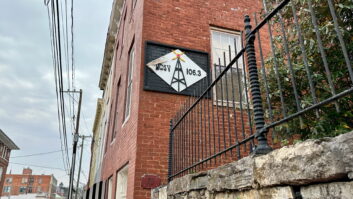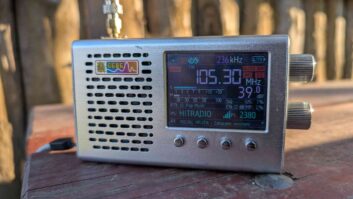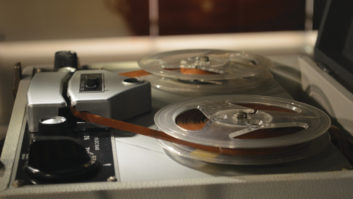
The Radio Station-Building Slentz Clan: Jerry, Dan, Tyler, Steve with Jody (Slentz) Brogan in frontDOVER-NEW PHILADELPHIA, Ohio — At 6 a.m. on Monday, July 13, WDPE(LP), aka “DNP 102.3,” went on the air. Beforehand, Jody Brogan, the president of the Dover-New Philadelphia Educational Broadcasting board, had often asked “What if no one listens?” My refrain was “If we build it, they will listen.”
There’s been a lot in print about the legal aspects, market research and all the trials and tribulations of building an LPFM radio station. This is about the technical aspects and description of how this station was built in 10 l-o-n-g days (16 to 22 hours per day of work). This included everything from mounting the antenna to building the studio and office furniture, wiring the transmitter rack, and of course, wiring the studio.
Initially, the board had a location for the new station, courtesy of a local businessman with a desire to help. The actual layout was designed over a year prior to the build, with nearly every aspect holding true to the design. I’m someone who “builds on paper first,” and this allowed the actual design and integration to go mostly as planned without any real surprises.
The radio station’s design started with the location, then the actual facility and then the technical integration.
The facility layout was conducive to having a radio station in it. It’s in a nearly 100-year-old J.C. Penney building in what had been management offices and later home to a weekly newspaper. The space consisted of one large area surrounding an office (with a window) and closet. This former office would become the studio, and the closet was rebuilt to become a transmitter room.


BeforeThe studio is under construction. Note the Visio wiring diagram on the wall. The layout has the studio in the rear of the station, visible through large windows. In the studio is a closet with large glass panel. A door designed as an “outside door” (exterior door) seals sound out of studio.
Outside the studio is a “DJ food/drink shelf” (no food in studio). There is a great reception area as you walk in the main door to the right. And to the left is a meeting/ public service/underwriting work area. Also in this area is a door for the “transmitter closet” for easy access to the gear without the need to enter the studio.
Technically, like most LPFMs, the station was “financially challenged” to do as much as it could with the biggest bang for the limited buck. That meant quality and dependability came first when choices had to be made.

The finished studio.

After There were plenty of places to go cheaper, but it was critical to make sure that no one that heard WDPE said “that sounds like an LPFM.” We’re on the dial just like any Class A station (or Class C for that matter), and nowhere on any consumer radio is there a choice for LPFM, Class A, Class B, noncom, etc. So being at 102.3 MHz meant we’d be between “the commercial big boys.”
I put my years of radio broadcast engineering experience to use in configuring the equipment list, selecting solid performers and what I felt were the best values for the money. (See the sidebar for the gear highlights.)
There are a lot of good manufacturers and many choices. A few items were donated, which accounts for their selection, though I would have probably chosen those items anyhow.
To explain a few choices: The single-bay OMB was a necessity since we were extremely limited to where we could mount it. The city had regulations limiting anything new on the roof and since the transmitter is collocated with the studio, we had to mount it to a security light pole. It hit our height, but no room for a second bay with proper spacing. Surprisingly — no, shockingly — the little one-bay puts out a great signal. The gain is only 0.46, but the headroom on the Nautel VS300 allows the compensation for the ERP of 100 watts when considering the line loss and lack of any antenna gain.

Transmitter rack closet.

Floor Plan The Inovonics 531N may seem extravagant, but as the station’s consulting engineer, I really wanted the ability to keep tabs on the signal and modulation (along with the competition). Though the station is legal in modulation, we have a perceived loudness of near the competition (which shows “exceeding the speed limit” in many cases). With the Nautel VS300, it’s easy to keep close tabs on all the technical aspects of the station when I’m not present.
INSTALLATION
For me, a really interesting part of the installation was Audioarts Air-4’s use of RJ-45 (Ethernet) connectors instead of more traditional connectors. As this was a first for me, I had to learn different ways of dealing with RJ-45s. For instance, there was no way I wanted to use solid conductor Cat-5 cable, so I purchased Cat-6 stranded and removed one end and put on the appropriate connector. Though I could have (or maybe should have) purchased custom cables, money was tight, and I had about every connector necessary to put on the non-RJ-45 side.
With the stereo, I pulled one pair and saved the jacket from the cable, reinserting it over the second pair allowing a clean installation of the audio pair over the wire. With the Audioarts RJ-45 connection, Pins 1 and 2 are one pair, while Pins 3 and 6 are the second (4, 5, 7 and 8 are unused)
Physical construction began with a highly-detailed drawing by a seasoned architectural designer. Okay, I did it without the aid of someone with that sort of talent, but my brother (a contractor) helped to transfer my chicken scratch into what I had in my mind.
The console furniture was basically built as a half wall (2 feet x 4 feet) with one side (guest side) solid plywood-covered with black carpet, while the jock side has removable panels to access the 66 punch-down blocks for control and some of the gear interconnects. The countertop was built with two sheets of plywood and trimmed off, then sprayed with a faux granite paint and sealed. All other wood was painted satin black to match the equipment and the monitor bridge (over the console). A hidden “wall trough” was added which led to 4-inch PVC conduit above the ceiling to allow all wiring easy access between the studio furniture and transmitter rack in the transmitter closet.
Walls and color choices match the two local town’s high school colors (crimson, gray and black). Walls were well insulated, so only acoustic foam was added to the walls (and leftover 2 x 4 pieces used for ceiling tile).
The Visio wiring diagram gave the engineering crew a solid road map to hang on the wall.
Click to Enlarge The wiring plan was done months in advance. Since I would be the only experienced engineer doing the wiring, I used Visio to draw a wiring diagram with color-coding for all of the cables to help others. For the most part, only Cat-6 was used. My vendor had Cat-6 in every color imaginable, so every type of source had its own unique color. A detailed sheet of which colored Cat-6 ran where was included.

Chad Felbush, our newly designated chief engineer, would prove a quick learner and his IT skills made configuration of the network relatively easy. Being a modern station, many pieces of gear made up our network including the transmitter, EAS gear, engineering laptop, on-air computer and production computer, plus ports for the rest of the station’s PCs.
The station took about two weeks to build from scratch — from our own home-built furniture to the studio, transmitter rack and wiring along with mounting the antenna. Everyone involved pulled many long hours with the “worst” workday lasting 22 hours!
Equipment Highlights
Single-bay OMB circular FM antenna
Andrews LDF4 coax
Nautel VS300LP transmitter with integrated Orban Optimod 5500 processor card
Digital Alert Systems DASDEC EAS system
Inovonics 531N modulation monitor
Symetrix amplifier
JBL Control series speakers
Audioarts Engineering Air-4 console
ElectroVoice RE 20 mics on O.C. White booms
Stanton C.400 CD players
Gentner Digital phone coupler
Symetrix headphone amp system
Broadcast Software International Simian automation (with other BSI broadcast software)
Adobe Audition
Cisco 24-port Ethernet switch
The list of those involved could take a full page and included board members, volunteers, friends and family members.
We finished up Monday morning at about 2 a.m. and launched the station on time, on schedule, and nearly on budget (some of us pitched in) Monday, July 13 at 6 a.m. with myself and brother Steve Slentz having the honor of launching the little station that could!
It was nothing short of amazing, maybe a miracle, to see it come together.
And “did they listen”? Oh yes! In my 35 years of radio, I’ve quite honestly never seen a station catch on as strongly as DNP 102.3 has. It’s on the air 24 hours a day, with live mornings (6–9 a.m.), afternoons (3–6 p.m.) and more live shows launching each week. You can learn more about DNP 102.3 programming and hear some demos at dnp1023.wix.com/wdpe.
Got a facility story to tell? Email Gear & Technology Editor Brett Moss at[email protected].







